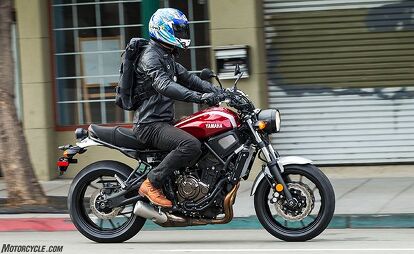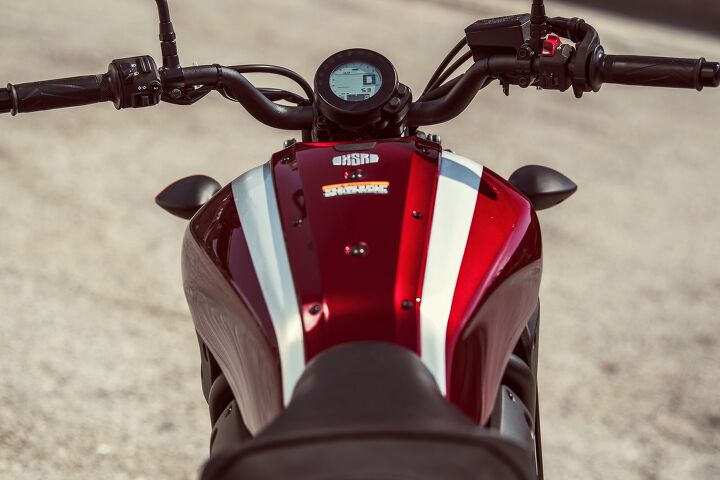2018 Yamaha XSR700 Sport Heritage First Ride Review
Whoever said, “you can buy fashion but you can’t buy style” has obviously never seen or ridden Yamaha’s all new 2018 XSR700 Sport Heritage. While this statement usually pertains to clothes, I don’t think it’s far off the mark when it comes to Yamaha’s new middleweight. The threads you wear and motorcycles you ride don’t have a lot in common, but one thing they do share is that they both allow you to express yourself and make a statement. Just about anything retro is “cool”, or in fashion these days, but what the wearer (or rider in this case) does with it ultimately evokes their style. The XSR700 makes it easy to do so on both fronts. Allow me to explain…
2018 Yamaha XSR700 Sport Heritage
| Engine | 19.0/20 |
| Suspension/Handling | 14.0/15 |
| Transmission/Clutch | 9.0/10 |
| Brakes | 8.5/10 |
| Instruments/Controls | 4.5/5 |
| Ergonomics/Comfort | 9.0/10 |
| Appearance/Quality | 9.0/10 |
| Desirability | 9.0/10 |
| Value | 9.5/10 |
| Overall Score | 91.5/100 |
Just to reiterate – retro is “in” right now. Call it what you want to call it, whether it be retro, vintage, classic or traditional, it’s all the same, and kids these days are into it. Take it from me, a 28-year-old, tattooed, hipster millennial – I should know what’s cool, right? Maybe not, but it’s what a large portion of my generation digs. Plus, it’s this younger demographic that manufacturers are targeting to help keep our industry alive, though anyone, regardless of age can look good on this bike.
Everyone wants the look and style of an old motorcycle but could do without the difficult hurdles of its ownership – mainly the reliability, access to parts and the overall lack of performance (by today’s standards, anyhow). Yamaha has elegantly bridged this gap with the XSR700 Sport Heritage. Drawing influence from its classic “XS” series, Yamaha blends world-class engineering with timeless style and has created a machine for riders looking for an authentic and honest motorcycle that doesn’t sacrifice performance or leave you stranded on the side of the road.
The styling of many modern bikes today is edgy, with plenty of sharp angles and aggressive lines. The XSR has taken a different, more relaxed approach with the use of round components that include a circular multi-reflector headlight, LED tail and brake light as well as a compact LCD instrument gauge. The gauge displays all pertinent information that’s thoughtfully laid out and easily discernible at a quick glance. These round lines certainly harken back to the styling of the XS models of the ’70s – which is cool, I tell you!
Just kidding, but what is cool is that Yamaha has engineered the XSR700 so that its owners can easily customize it to their liking. In fact, Yamaha encourages it. The gas tank has three covers (left, right and center), that are easily unbolted and can be painted any-which-way you want if the matte gray aluminum or raspberry metallic don’t tickle your fancy. There are also other raw aluminum covers and braces that can be painted or left bare – the bike will look good, either way. The rear portion of the subframe is removable to further aid and simplify customization. In addition, Yamaha has a whole slew of accessories specific to the XSR700 including everything from number plates to adventure saddlebags to truly make it your own.
While looks and styling are obviously important factors when influencing and attracting potential buyers/riders, it’s the bike’s meat and potatoes that will ultimately determine its value. Nobody wants a bike that’s all show, no go. Hands down, my favorite part of the XSR700 is the motor. Why? It’s a torque monster. Yamaha claims 50 foot-pounds of torque from the 689cc liquid-cooled, parallel twin-cylinder DOHC engine, but given how happy it is to loft the front end, you’d think it had a bigger motor. Ripping first, second and even third gear wheelies out of almost every turn is as fun and easy as it sounds. Coming to a stop sign or red light isn’t even that bad because it means you get to feather the clutch and click through those gears all over again – it’s addictive.
Yamaha designed this motor to “maximize riding excitement in the real world,” and they succeeded. The XSR700 has super usable power and is a pleasure to ride in and around town. Exciting as the motor may be, it’s never overwhelming and delivers linear power that keeps pulling all the way up through redline, which makes it no slouch in spirited jaunts through the twisties. There are two major benefits to this: the predictability and user-friendly nature of the motor lends itself well to less experienced riders in building their confidence but can provide plenty of thrill to faster riders, too.
Going fast is no fun if you can’t slow down though, right? Scrubbing the XSR700’s speed is a pair of 282mm floating discs with four-pot calipers in the front and a 245mm disc in the rear. ABS comes standard to prevent wheel lock under heavy deceleration and works well when triggered. One of my biggest ABS pet peeves is when it’s too eager to engage, but the XSR’s unit finds a nice balance without any disconcerting modulation at the lever. Kudos.
Keeping the XSR700 composed is a non-adjustable 41mm telescopic fork and a link-type monocross rear shock with preload adjustability. Each delivers 5.1 inches of suspension travel and together are tuned to provide a balance of comfort and control ideal for the street. The bike floats over railroad tracks and manhole covers gently but stays firm and planted while leaned over through rougher, choppier pavement as well. You can push the XSR700 pretty darn deep into a turn, and it holds its arc nicely.
Yamaha designers and engineers did a bang-up job in creating a great all-arounder. Whether it be commuting, sporty riding or long hauls down the freeway, the XSR700 has comfortable ergonomics to do it all. Compared to its FZ-07 (now MT-07) brother, the XSR’s 29-inch wide bars are about 3 inches wider and just a tad closer to the rider. This offers an open and roomy cockpit with an upright seating position that provides the pilot with plenty of leverage to throw the bike in and out of turns but also comfort for longer rides. The tank is recessed effectively where your thighs can comfortably squeeze the bike, which in turn makes it feel super thin and nimble as a result.
Adding to the XSR700’s flickable handling is Yamaha’s claimed 410-pound wet weight, which is certainly lighter than most other middleweight bikes in its class. The bike’s light weight paired with its 25-degree rake make it a corner slayer, however it’s also very stable at speeds north of 80. Most Southern California freeways have little rain grooves that like to steer the bike in whichever direction they please. This sensation can be unnerving and it intensifies with more speed, but the XSR700 goes where you point it without any sort of backtalk or ideas of its own.
A couple other comfort characteristics worthy of noting are the seat and the lack of vibration transmitted from the motor. The two-level, stitched saddle is soft in all the right places and positions you comfortably forward right up against the tank. My upper inner thighs thank you, Yamaha, as that’s usually where any sort of discomfort is focused. Paired with the engine’s “Crossplane Concept” 270-degree crank is a vibration-reducing counterbalancer that doesn’t leave your hands or feet tingling after a long haul.
All in all, the XSR700 Sport Heritage is a solid motorcycle, and it’s fun to ride. I get excited just thinking about it. This is perhaps its greatest strength because above all else, riding motorcycles is about having fun, and the XSR provides plenty of it. We look forward to putting more miles on the thing to further determine where it shines and where it may falter, but so far, our first impression is positive. No question. And as far as the saying “you can buy fashion but you can’t buy style” goes, you can pick one of these up for $8,499. Yamaha will provide the fashion, and you can provide the style as you wheelie off into the sunset, or to the next light, whichever comes first.
Wheelie pics and video coming soon!
2018 Yamaha XSR700 Sport Heritage
+ Highs
- Addictive power character
- Great versatility in and out of town
- Good bones (motor and chassis)
– Sighs
- Could offer more suspension adjustment
- Would be nice to disable rear ABS
- I can’t really think of anything else without really nit-picking. For what it is, the bike does everything exceptionally well
2018 Yamaha XSR700 Sport Heritage Specifications | |
|---|---|
| Engine Type | Liquid-cooled DOHC Inline twin cylinder; Four valves per cylinder |
| Bore and stroke | 80.0mm x 68.6mm |
| Capacity | 689cc |
| Torque (claimed) | 50 lb-ft |
| Fuel system | Fuel injected with TCI: Transistor Controlled Ignition |
| Final Drive | Chain |
| Front Suspension | 41mm non-adjustable telescopic fork; 5.1-in travel |
| Rear Suspension | Single Monocross shock, adjustable preload; 5.1-in travel |
| Front Brakes | Dual hydraulic 282mm discs with 4-piston calipers; ABS |
| Rear brake | Hydraulic 245 mm disc with single-piston caliper; ABS |
| Wheels and Tires | Cast aluminum; Front: 3.5”x17” Rear: 6.00”x17” Radial Pirelli Phantom Sportcomp. Front: 120/70ZR-17 Rear: 180/55ZR-17 |
| Saddle height | 32.9 inches |
| Rake | 25-degrees |
| Trail | 3.5 inches |
| Wheelbase | 55.3 inches |
| Curb Weight | 410 lbs (claimed) |
| Fuel Capacity | 3.7 gallons |
More by Brent Jaswinski











































































































































































































































Comments
Join the conversation
I'm sure that when you're ON it it's indeed a nice ride. However, I can't get past the part when you're OFF the bike. First things I see are the radiator and that tank. I think Yamaha is, by the looks of it, trying to create a sort of Ducati Scrambler/retro sort of bike. Instead, it's neither and hence, looks weird. I like the rear light and speedo/display. Both bare bones round. Even the riding position is something I appreciate. But when your eyes venture onto that tank and huge "cooling rectangle" it becomes a mess. Keep it simple Yamaha. Want to be retro cool? Bring back the XS650. I'm betting you'd sell more than this XSR. Easily.
I'm sure if I rode this bike I'd probably like it as much as the tester here did. But the looks kind of kill it and the gimmicky appearance options aren't going to change that.
the comments about it being fugly? I hear this trash but truth is it doesn't cost much to mod the bike. Most of us swap the blinkers, remove the tail, but keep the rear fender, swap the levers, cover the radiator, and some will chop the front fender change the headlight, bike looks damn good to me. https://uploads.disquscdn.c...